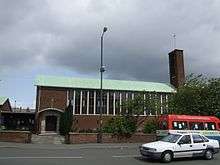All Saints' Church, Darlaston
| All Saints’ Church, Darlaston | |
|---|---|
 All Saints’ Church, Darlaston | |
| Coordinates: 52°34′10.1″N 2°1′34.39″W / 52.569472°N 2.0262194°W | |
| Location | Darlaston |
| Country | England |
| Denomination | Church of England |
| History | |
| Dedication | All Saints |
| Consecrated | 1952 |
| Architecture | |
| Heritage designation | Grade II |
| Designated | 22 February 2016 |
| Architect(s) | Richard Twentyman |
| Groundbreaking | 1951 |
| Completed | 1952 |
| Specifications | |
| Length | 120 feet (37 m) |
| Width | 45 feet (14 m) |
| Height | 56 feet (17 m) |
| Administration | |
| Parish | All Saints Darlaston |
| Deanery | Wednesbury |
| Archdeaconry | Walsall |
| Diocese | Diocese of Lichfield |
All Saints’ Church, Darlaston is a parish church in the Church of England in Darlaston.[1]
History
The first church by George Edmund Street dated from 1872. It was erected as a memorial to Samuel Mills, and lavishly furnished with stained glass windows designed by Edward Burne-Jones. It was destroyed by a bomb in the Second World War on 31 July 1942.
The replacement church was started in 1951 by the architect Richard Twentyman and dedicated on 4 October 1952 by the Bishop of Lichfield. The church tower containing two bells is 56 feet (17 m) high. The main body of the church is 120 feet (37 m) long by 45 feet (14 m) wide.[2]
The east end of the church is dominated by a tapestry designed by Stephen Lee, and the stone reliefs on the main door are by Don Potter.
The church was listed at Grade II by Historic England on 22 February 2016.[3]
Organ
The church is equipped with a pipe organ by John Compton. A specification of the organ can be found on the National Pipe Organ Register.[4]
References
- ↑ The Buildings of England. Staffordshire. Nikolaus Pevsner. Penguin Books. ISBN 0140710469 p.297
- ↑ "Darlaston church rebuilt from the ashes of war". Black County Bugle. 6 September 2012. Retrieved 28 March 2015.
- ↑ Historic England. "Church of All Saints, Darlaston (Grade II) (1431982)". National Heritage List for England. Retrieved 23 February 2016.
- ↑ "NPOR N03189". National Pipe Organ Register. British Institute of Organ Studies. Retrieved 28 March 2015.